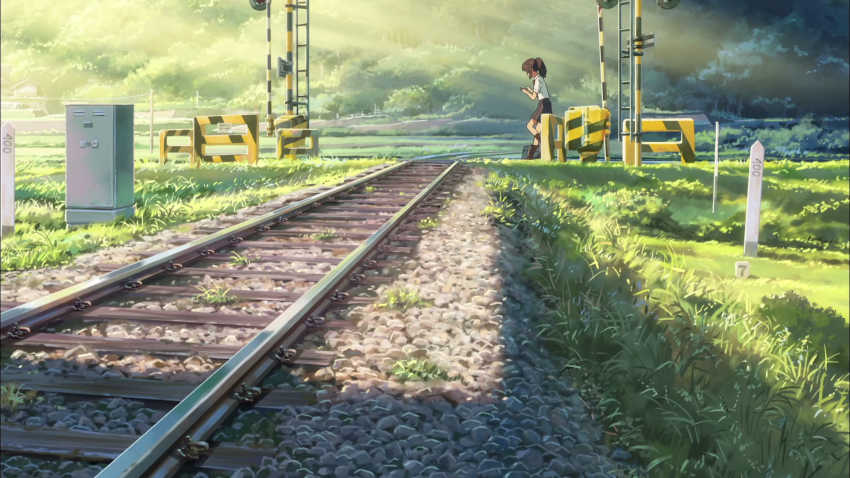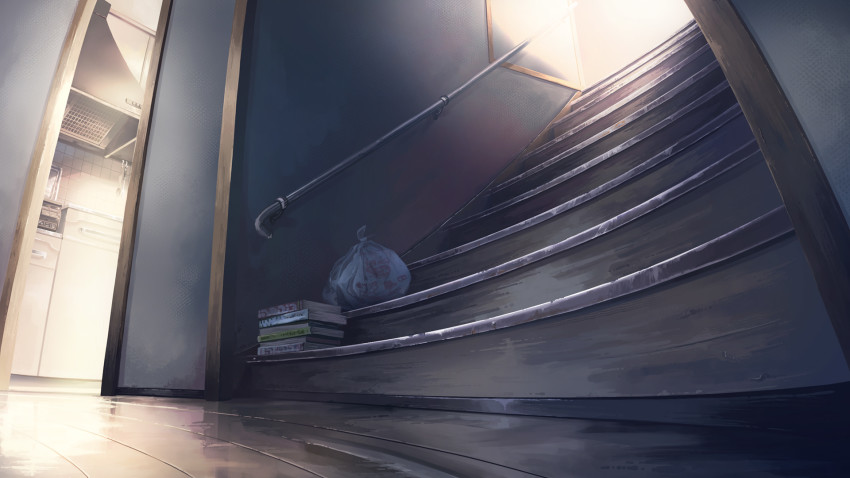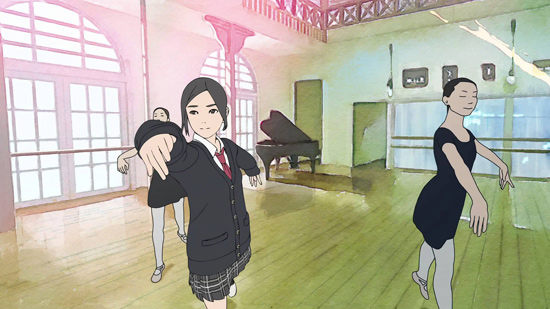Interview: Mateusz Urbanowicz
June 21, 2018 · 1 comment
By Andrew Osmond.
 If you’ve wondered about the artists who created the incredible backgrounds for Makoto Shinkai’s Your Name, then meet Mateusz Urbanowicz. The Polish-born artist painted more than 120 backgrounds for Shinkai’s blockbuster (examples). He also contributed almost a hundred others to The Case of Hana and Alice (examples) and worked on an episode of Space Dandy to boot.
If you’ve wondered about the artists who created the incredible backgrounds for Makoto Shinkai’s Your Name, then meet Mateusz Urbanowicz. The Polish-born artist painted more than 120 backgrounds for Shinkai’s blockbuster (examples). He also contributed almost a hundred others to The Case of Hana and Alice (examples) and worked on an episode of Space Dandy to boot.
But that’s just a small part of Urbanowicz’s thriving artistic career. As a computer graphics student in Poland, he used a Japanese government scholarship to enrol at Kobe Design University, where his animation project was a film called Right Places. His initial trailer caught the attention of Shinkai when he visited the university, and the director gave Urabanowicz tips for completing the film – you can see the final work here.
Many of Urbanowicz’s personal works are illustrations, including his series “Bicycle Boy”, which was inspired by Ghibli. He’s also created other illustration series such as Tokyo Storefront and Cold in Yokohama. His English-language website is here while he also has a Youtube channel.
Hello Mateusz. What were your first visual impressions of Japan when you arrived in the country?
I knew the Japanese visual culture a little even before actually coming to Japan. I watched a lot of animation and read some comics – the deep and wide visual culture that touches a lot of topics was what I felt from those works and was what I felt was missing in Poland.
Coming to Japan only confirmed what I was expecting. It was obvious that the visual culture is everywhere here, from illustrations, posters, comics, commercials, leaflets to the comics and animations. What’s more, creators are appreciated for their work and skill. Working as a visual artist is not treated as weird or as giving up on a “proper” career.
 Do you think it’s substantially easier to make a living in Japan from creating illustrations and backgrounds, rather than as an animator?
Do you think it’s substantially easier to make a living in Japan from creating illustrations and backgrounds, rather than as an animator?
Generally creators in Japan are appreciated, and can make a good living as freelancers and artists making their own illustrations, comics etc., especially if they manage to make their brand and name recognizable. With animators, it’s a little different. A lot of them do not work as artists per se (no offense meant here) – trying to make their own art, promoting themselves in the art environment. Rather animators are very specialised, very skilled craftsmen working from tight scheduled project to tight scheduled project. I think that their awesome work should be appreciated and paid for more.
You arrived in Japan several years ago. In your personal work, do you feel that your tastes, the buildings and perspectives that interest you, are changing as you stay in Japan longer?
When I came to Japan I was still “star struck” with the mainstream illustration and character art – with the direction that is still most popular in Japan, aiming for cute (“moe”) or cool young characters, heart-warming stories.
Now, after few years, I realised the mistake of my ways a little. I decided to look a little deeper for themes other than just what people want to see, and create art that I think has values that are needed right now.
In anime, backgrounds (and background environments such as the interior of a train carriage) are often very important, much more than in most live-action works. Do you have some thoughts on how backgrounds are such a vital part of the storytelling of anime?
In good live-action movies backgrounds are also used to their strengths (laughs). The difference is that with animation backgrounds you can freely adjust each aspect of the scene, and also make little “lies” where needed to achieve the atmosphere needed for the scene. This is hard because the possibilities are virtually unlimited.
 I really enjoyed your film Right Places. Of course, some of the shots in the trailer feel reminiscent of Shinkai’s work. Was this coincidence, or were you partly inspired by Shinkai’s anime such as Voices from a Distant Star? Were you already hoping to join CoMix Wave Studio?
I really enjoyed your film Right Places. Of course, some of the shots in the trailer feel reminiscent of Shinkai’s work. Was this coincidence, or were you partly inspired by Shinkai’s anime such as Voices from a Distant Star? Were you already hoping to join CoMix Wave Studio?
At that time I was mainly painting my works, and especially colour backgrounds, digitally. So naturally, when I started to do my short animation I tried to study those animated movies that I thought had the best looking digitally painted backgrounds (not just them, of course). I learned a lot from the art-books that were published for Shinkai’s movies and incorporated a lot of this knowledge into the style of “Right Places”.
I did not know that joining the studio was even possible when I started making it but I got invited halfway through, after Shinkai himself and his producer saw the trailer. I still had to finish the whole animation though!
You mentioned that the trailer had a good response from the Japanese animation industry. How did you maximise your chances of the work being seen by animation professionals?
Mostly I tried to make it as accessible as I could for Japanese audience, making the dialogue in Japanese, making DVD and Blu-ray copies, uploading it not only to YouTube but also to the Japanese niconico website etc.
How did you come into contact with CoMix Wave?
I was very lucky here – Shinkai himself came to our university to do a special lecture about story making in animation. At that time I had the trailer for Right Places almost ready so I handed him a disc with the current version. He saw it after his lecture ended and called me backstage to learn more about me and my works, and to ask me if I was interested in working in the Japanese animation industry.
On your website, you give “Thanks to Makoto Shinkai” for the 5-minute version of Right Places. Did Shinkai give you advice or support for the film?
Yes, when I came to Tokyo to visit the animation studio, I still had not started working on the full version of the short movie. I was able to show Makoto Shinkai the movie storyboard I had and ask for advice on timing, music and other aspects. This was my first animated project ever so I was making a lot of things up as I went. His advice was very helpful and confirmed some of my decisions.
You worked extensively on Your Name. Among the backgrounds that you created, do you have any favourites?
I think I enjoyed working on all the backgrounds more or less the same. Of course, later, after the movie was finished I was very happy that some of the backgrounds I did became really popular and important for the movie – for example the overhead pedestrian passage scene – and were used for posters and other promotional materials. Some of them even became a reason for fans to visit the real places!
I think I like the city backgrounds I painted the best, just because I think they were the ones that fit my digital painting style the most.
In order to create the Itomori backgrounds in Your Name, did you visit Gifu or any other country area for research?
I didn’t, but the main staff of the movie did extensive location hunting to decide the image of Itomori, which is an amalgam of many places.
How did it feel for you as Your Name grew into an incredible commercial phenomenon?
I was really happy that we made a movie that spoke to so many people and could compete with the popular 3D animated productions.
Your Bicycle Boy images were used in a Studio Ghibli book about Whisper of the Heart. Did the Ghibli staff see your images online, or did they find out about the pictures another way?
I and not quite sure about how this came to be, though I suspect the involvement of my university professor, Eiji Otsuka. I like the Whisper of the Heart movie a lot, and also have some fond memories tied to it as it was the thing that inspired my first watercolour illustration series (the “Bicycle Boy” series) that kind-of kickstarted my current online presence. I’m really happy and honoured that this work went full circle and was featured in a book about a movie that inspired it in the first place, along with interviews with the people who actually made it.
 Regarding Hana and Alice, how did you go about turning a photo into a background in the film?
Regarding Hana and Alice, how did you go about turning a photo into a background in the film?
I’m afraid that I cannot tell everything here, but the movie was a very interesting project as it was first shot on film using actors. This video was then used as a reference for the 3D animation and also as a base for the backgrounds. We edited the footage where it was needed (for example: it was shot in winter so we had to add flowers, leaves on trees, erase the snow etc). We then used a special piece of software to make the photo look “watercolory,” and used this file as a base to paint with watercolour-like brushes in Photoshop.
The deadline was close and the team was relatively small – so we had to figure out a method to make the painting process fast. Of course some of the backgrounds no longer existed, and had to be painted from scratch, such as locations from the previous movie [the live-action Hana and Alice film from 2004] that no longer existed, like the ballet classroom.
Your new film, “Susume, Karolina” (trailer), is sponsored by the makers of CalorieMate. Were you involved in the process of getting a sponsor, or was the sponsor arranged by the Colorido studio?
CalorieMate became the official sponsor of the professional, female shōgi (Japanese chess) player Karolina Styczyńska first. As an element of the promotional campaign that is aimed to support her career they asked me to make and direct a short animation that would present Karolina’s image to everyone. I was given almost complete free reign on the content of this animation but to realize it I needed the help of an animation studio. I was very lucky that studio Colorido agreed to participate in this project when I asked if they would.
Is there a release date for “Susume, Karolina” yet, and can you say how long the film will be?
This is a short animation (about 3 minutes long) that will be published online at the end of June. I hope you’ll enjoy it!
Andrew Osmond, anime, case of hana & alice, Japan, Makoto Shinkai, Mateusz Urbanowicz, Shunji Iwai, Your Name
Tachibana Kanade
June 21, 2018 12:24 pm
Who is Makoto Shinaki?